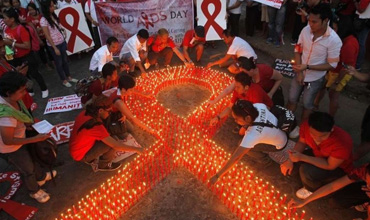Exposed HIV infants who had their DBS sample collected, tested and received result in past 12 months (January-December 2013) at Specialist Hospital Yola, Nigeria

Abstract:
This
study is a retrospective study design to examine the outcome of babies born to
HIV-positive mothers in Specialist Hospital Yola, Adamawa state, Nigeria. The
total population of women who tested HIV-positive and accessed antenatal care,
intra-natal care and post natal care and were enrolled for PMTCT at Specialist
Hospital, Yola between January 2013 and December 2013 and infants below 24
months .
The
objective of this study is to determine the number of the exposed infants that
received PCR service using DBS as compared with the total number of positive
pregnant mothers and also to identify the gaps with the view to correcting them
Total ANC attendee
was forty thousand three hundred and Seventy four (40,374) pregnant women of
which Eleven thousand three hundred (11,300) received counseled, tested and
received results for HIV. Two hundred and Nineteen (219) 1.9% tested were
reported positive. This makes up 1.9% of the population tested. The HIV testing
among HIV-exposed
Infants within the health care
facility were (133) 60.7%. The prevalence of HIV infection among
HIV-exposed infants
who were tested by HIV-1 DNA PCR method was (8) 8.4%. 95 (71%) of the total DBS
sample collected had their results. 38 (28.6%) of the infants never received
their result.
The facility had
intermittent supply of commodities for EID of HIV, trained human resources,
system of identification of HIV-exposed infants. Early HIV testing during
Pregnancy, PMTCT ARV
prophylaxis, disclosure of HIV status, enrollment to care and treatment,
frequent attendance to EID services, co-trimoxazole prophylaxis and exclusive
breast feeding was found to be significant predictors for testing of
HIV-exposed infants.
References:
[1.] (n.d.). Retrieved April 7, 2014, from www.poz.com/arcchives/2008_march_2168
[2.] Aledort JE, R. A. (2006). Reducing the burden of
HIV/AIDS in Infants: the contribution of improved diagnostics. Nature, 444
suppl 1. 19-21.
[3.] Assembly, U. G. (2011). Political declaration on
HIV and AIDS: Intensifying our efforts to eliminate HIV and AIDS. Geneva:
UNAIDS.
[4.] Cassol S, S. T. (December 1992). Stability of dried
blood spot specimens for detection of human immunodeficiency virus DNA by
polymerase chain reaction. J. Clin. Microbiol.30 (12), 3039-42.
[5.] Chou R, H. L. (2005). Screeening for HIV: a review of
evidence for the U.S Preventive Service Task Force. Annals of Internal
Medicine143(1), 55-73.
[6.] Ciaranello AL, P. J.-A. (2011). Early infant HIV-1
diagnosis programs in resource-limited settings: opportunities. BMC Med.
[7.] Douek DC, R. M. (2009). Emerging Concepts in the
Immunopathogenesis. Annu. Rev.Med 60, 471-84.
[8.] en
wikipedia.org/wiki/infection
[9.] en
wikipedia.org/wiki/Dried_Blood_Spot
[10.] Generalized
epidemic in sub Saharan Africa. Journal of international development 13(4)
451-466
[11.] HIVand
AIDS. Geneva: UNAIDS
[12.] Hassan AS, S. E. (2012). .Dynamics and constraints of
early. AIDS and Behavior. 16(1), 5-12.
[13.] Kumaranayake L, W. C. (2001). Resource allocation and
priority setting of HIV/AIDS interventions: addressing the generalized epidemic
in sub-saharan Africa. Journal of international Development 13(4),
451-466.
[14.] Muhimbili
University of Health and Allied Science by JG Gamaliel 2012
[15.] Nuwagaba H.B., S. W. (2010). Introducing a multi-site
program for early diagnosis of HIV. BMC Pediatr.
[16.] Parker SP, C. W. (September 1999). The use of the
dried blood spot sample in epidemiological studies. J. clin. pathol.52 (9),
633-9.
[17.] Post
exposure prophylaxis against human immunodeficiency virus. American Family
Physician 82(2):161-6
[18.] RA, W. (1993). How does HIV cause AIDS ? Science
260(5112), 1273-9.
[19.] Stability
of Dry Blood Spot specimen for detection of human immunodeficiency virus DNA by
polymerase chain reaction. J.clin.microbiol.30 (12):3039-42
[20.] Schools-wikipaedia.org/wp/h/hiv.htm
[21.] S, K. (2004). Patient inforation: Blood donation and
transfusion. uptodate.
[22.] Tolle MA, S. H. (July 15, 2010). Post exposure
prophylaxis against human immunodeficiency virus. American Family Physician
82 (2), 161-6.
[23.] Wikipedia
Dry Blood Spot, 3/27/14
[24.] www.Pathfinder’s.org
, early infant diagnosis
[25.] www.emtct-1qtt.org
: utilization of HIV and AIDS -mother to child transmission
[26.] www.Independent.org/
Delusions of power by Robert Higgs
[27.] www.update.com
[28.] www.plosone.org
[29.] www.scirp.org/journal/paper
download. J. Purushottam, 2012
[30.] www.youtube.com
question/index?qid
[31.] www.intergayhiv.com/Humanimmunodeficiencyvirus-hiv
[32.] www.Ihaveachronicdisease.com/hivaids
[33.] www.POZ.COM/archives/2008_mar_2168.shtml
[34.] www.andrenaingram.org/always-to-contract-hiv
[35.] www.palneetclinic.com/index
[36.] www.sanfordburnham.org

